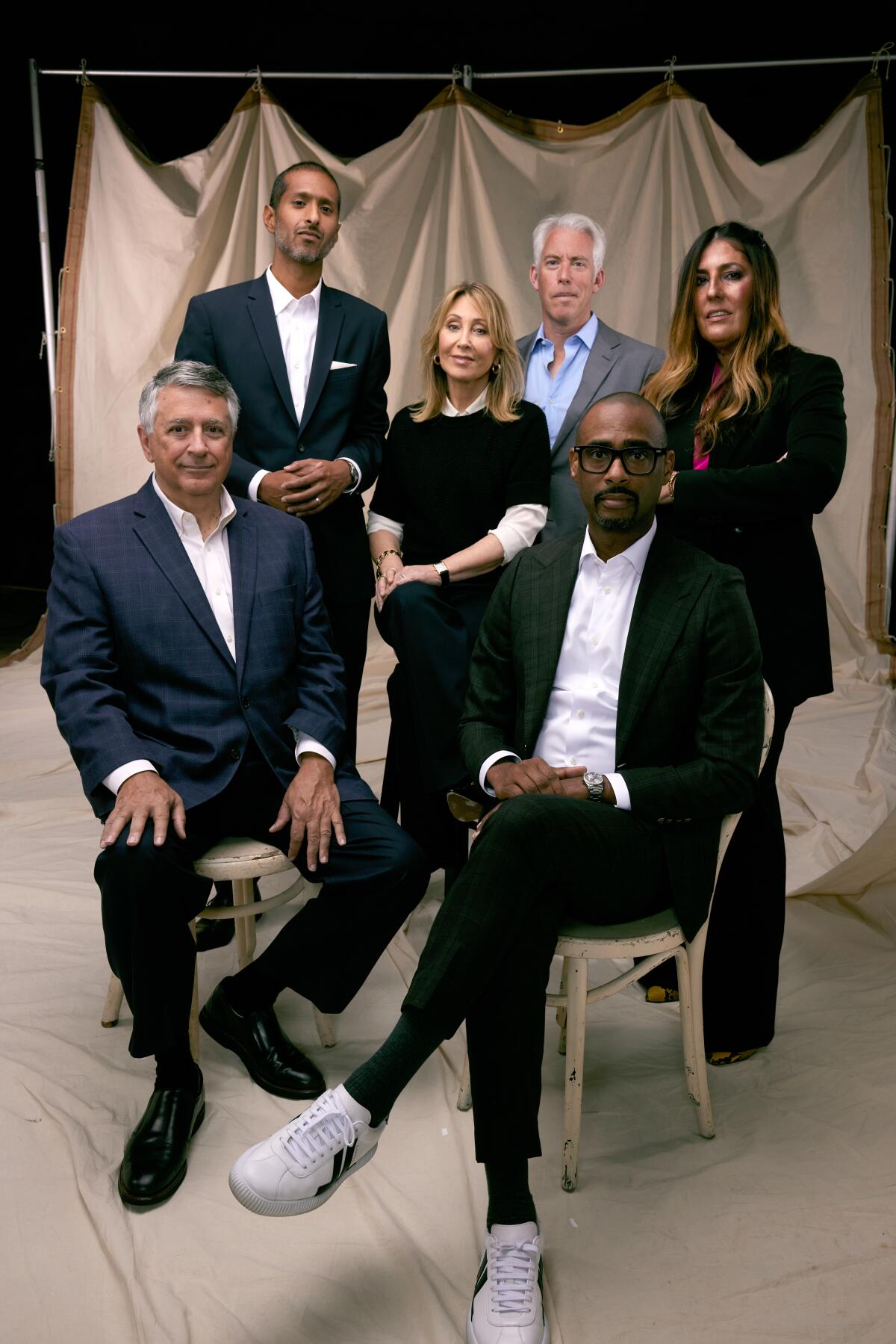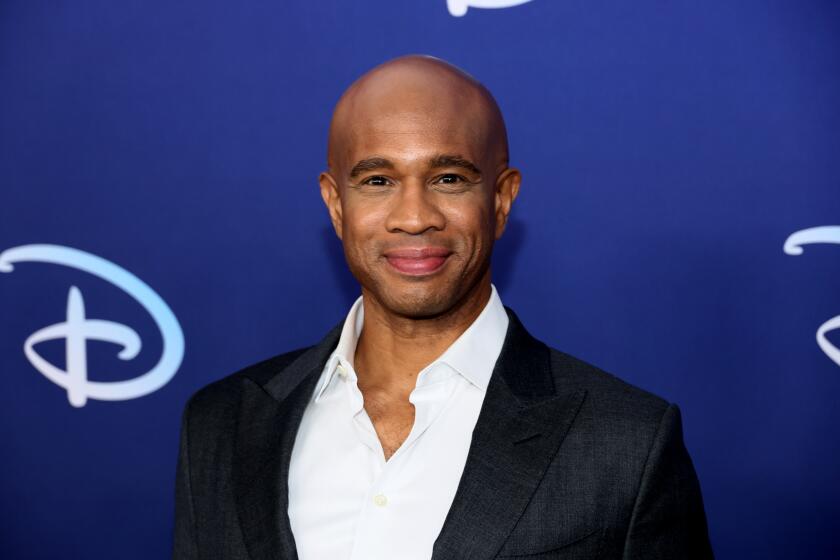Hollywood is in flux but these executives sound an optimistic note on the future of streaming, movies

Hollywood’s awards season is meant to be a celebration of the best in film and television. But these days, it often takes place against the backdrop of turmoil and anxiety in the entertainment industry, which is facing an uncertain economic climate and a business model that is in a dramatic state of flux.
Subscription-based streaming video, once the north star for media companies wanting to stay relevant in the age of Netflix, has come under question as Wall Street demands to see profits, not just subscriber growth at all costs. TV ratings are falling, cord-cutting is accelerating, and many analysts fear that the COVID-19 pandemic left a “permanent scar” on the theatrical movie business, as Walt Disney Co. Chief Executive Bob Iger recently put it.
Studios and streamers continue to spend billions of dollars on movies and TV shows for all formats, but worries about inflation and a possible recession have triggered a slowdown in the advertising market and rounds of layoffs and cost-cutting at many companies.

The ascent of Daniel, a close Bob Chapek confidant, to the chairman level was a point of pride for many at Disney in 2020, but he headed an organization that angered creative executives.
There are fewer movies in theaters than there were before the pandemic closed movie houses in 2020. And those films that do make it to theaters often are there for much shorter periods.
And still, the people who lead the companies at the heart of all this change remain optimistic.
The Times invited a panel of top entertainment industry executives from companies such as Sony Pictures, Blumhouse, Paramount Global and Creative Artists Agency to participate in a wide-ranging discussion of issues, including what kind of consolidation to expect, the next phase of the streaming wars and how to continue the momentum for progress in diversity and inclusion, an area where the business has historically struggled.
The panel discussion was moderated by staff writers Anousha Sakoui and Ryan Faughnder. This conversation was edited for length and clarity.

What was your biggest success this year?
Abhijay Prakash, president, Blumhouse: We’re in the horror, thriller, true-crime genre storytelling business. It’s amazing that it’s having such an incredible culturally resonant moment, and we’ve been the beneficiary of that. ... If I had to pick one, I would say “The Black Phone” ... not just because it’s one of the most profitable movies we’ve ever had but also because of what it meant kind of culturally and for the business.
Jim Burtson, president, CAA: We closed on the acquisition of ICM, which added over 450 new colleagues to the company ... and that’s been a great success so far.
Stacey Snider, co-founder and CEO, Sister: We began the company six months before the pandemic. So it’s reassuring to know that the assumptions we made before the pandemic about what an independent media company can be and should look like have borne fruit.
Charles D. King, founder and CEO, Macro: Over the course of the pandemic, we actually more than doubled in size, and we invested in two verticals where we really doubled down on our representation group, M88, which represents top-tier filmmakers, movie stars, producers and multihyphenate artists, and also our television studio. And then what we’ve seen over the course of 2022 is that that investment is now really paying off.
Nina L. Diaz, president of content and chief creative officer, Paramount Media Networks and MTV Entertainment Studios: In addition to expanding our hit franchises like “Yellowstone” and “The Challenge,” we’re really proud of strengthening our commitment to diversity and inclusion, starting with the Mental Health [Media] Guide, which we launched and founded last year. And we have 20 industry partners now ... and we’ve had over 50 shows that have incorporated mental health storylines last year.
Tony Vinciquerra, chairman and CEO, Sony Pictures Entertainment: Five years ago, we set a strategy of being what we euphemistically call the arms dealer for the industry, and it’s been unbelievably positive for us. We’ve had a lot of very positive things. One, we’re about to consummate a merger in India between our channels business and our SVOD business in India ... which is the fastest-growing country in the world. And secondly, Funimation and Crunchyroll came together, our two anime services, and that has gone extraordinarily well. We’re at nearly 10 million subscribers there and it’s very profitable, unlike most of the other streamers.

The business model for Hollywood is in flux. What keeps you up at night?
Vinciquerra: There’s not enough films in the theaters. When you put a good film in the theater, it does well. “Spider-Man: [No Way Home]” did $1.9 billion without China. That’s something that we do worry about, China. And Russia is now a nonmarket for us. So those things are concerning. But ... if you put a good film in the theaters, it does well. We had “The Woman King” in the theaters just recently, which crossed over into a very broad audience and it’s doing very, very well, and we’re hoping that it’ll get into the awards consideration this year.
And on the TV side, the business has changed 180 degrees. ... Instead of getting 22 episodes and hopefully five seasons, now you get eight, 10 episodes, maybe 13 if you’re fortunate. And you’re lucky to get three seasons.
Snider: I’d have to say that my big worry is about discoverability. Valuable content is content for which there’s an affinity, where you can build community, where people can really experience it and talk about it. And that’s what has always made the libraries of the studios really valuable. It’s not volume, it’s familiarity and affinity. And so I do worry that, with the volume and with the split attention, that the opportunity for that close connection between the audience and the creative work is harder to build.
Vinciquerra: And navigation.
Snider: That’s right. What the studios have done in the past so well is make the shows so readily and easily available that people can discover them and then talk about them and feel a connection to them. And I think that’s what creates value for the creator; that’s what creates value for the studio.

Everyone has a streaming service now. What’s the next phase of the streaming wars?
Burtson: You’ve seen a consolidating marketplace for the last few years. What you see is that these companies, even if they are in flux, for the most part, these are very large spends and commitments into content. And from where we sit right now, it’s still really robust.
Prakash: There’s a lot that the streamers are trying to figure out right now. You obviously have this macroeconomic uncertainty that’s looming over everything. And so, in that environment and the stock market pressure that all of them face about demonstrating a path to positive cash flow, they’ve got to figure out how to compete and win subscribers. And now what’s next? We like to bet on upside, bet on ourselves, right? Make the content, film or TV, for the lowest price possible and then participate in the wins. And that model doesn’t really exist in streaming.
King: We’re a media company that’s focused on the BIPOC community — with people of color at the center of it from a global perspective. And it’s clear that the numbers of this demographic are driving subscriber growth. They’re watching more content, and at a higher percentage. And so, it’s actually working in our advantage because ... all these platforms recognize that there’s growth in the area that we’re focused on.

Box office has not come back as quickly as anyone hoped. What’s the future of theatrical exhibition?
King: There’s absolutely still going to be theatrical. There are certain eventized movies that will absolutely work and that will be as big and as robust as they’ve ever been. But clearly that’s not everything. I think there’s going to be the bulk of movies that are going to be on streaming platforms, and it’s going to be right for movies that are in the middle. There are those movies where you finance smaller ones you think have that upside, and then there’s some movies that are better for partners in a streaming arena.
Vinciquerra: We had four films this summer — “Bullet Train,” “Where the Crawdads Sing,” “The Woman King” and “Lyle, Lyle, Crocodile” — all doing well, all original films. What we’re seeing right now is what we’ve been calling the COVID intermission. Two years ago, people weren’t producing films, and we’re seeing that right now. Starting next April and May, it’s going to be crazy in terms of the number of massive releases and big movies. When there are three or four films released in a particular week, it’s back to 2019 numbers.
Prakash: The improvement of in-home screens and the availability of content on streaming services — all those things accelerated during the pandemic. The threshold for getting people to leave their house — that bar is high. I think what will be really fascinating to see is what clears that threshold, what gets people to leave the house.
Snider: It’s exciting for me to hear you say, “to keep the bar high.” I love that. That’s the kind of challenge I want everyone at Sister to be excited about.
Prakash: If you can get into the theaters, you get the benefit of theatrical exposure, plus downstream money that comes from streamers, or you start on the streamers and that’s a great place to find an audience for certain kinds of movies. So if you calibrate it right, it’s a really great time to be producing.
King: But that’s the biggest thing, you have to calibrate it right. You make sure to hold them in theaters just long enough to really maximize the value.
Vinciquerra: Today, everything’s very fluid. And the length of the window is now different for a film.
Snider: As it should have been before the pandemic.
Vinciquerra: Some films are 17-day windows, some are 45-day windows, some were 53-day windows, some were 90. “Spider-Man” was over 100. You customize the window to how the film is performing. Exhibitors weren’t thrilled about that, but they’ve now come to understand that that’s the right way to do it.
Burtson: I think the flexibility that Tony’s referencing is actually evidence of it being in a healthier state. When we look at it through the lens of CAA, we’re trying to just place the content for the right platform.
Snider: And maybe we shouldn’t be thinking about it in such a one-or-the-other way.
Talent deals are changing with streaming. What’s your big ask for clients when negotiating deals?
Burtson: They’re asking for the same things. It’s not only about guaranteed compensation. If the creator is willing to bet on their prospects, you want to create a deal that aligns interests on the upside, if that’s available to you. It’s also about making sure that the client, whether they’re in front of the camera or behind the camera, has the support and flexibility that they crave, that helps them achieve their ambitions.
Snider: I wish that the studios and the distributors and the streamers recognized also that when creators have skin in the game, their work shifts. It just does. I’ve been on both sides of it now.
King: We’ve all read the articles about very smart entertainers and media personalities taking and understanding the value of their brand and raising capital and creating asset value for themselves and their families. And that’s something I saw during my time when I was an agent, before I launched Macro, when I was Tyler Perry’s agent, and you look at the incredible empire that he’s now built. But what we’re seeing is, many of the smart celebrities who are uniquely positioned, they’re doing that themselves.
Burtson: It’s about reserving the rights for those things when you don’t quite know what they’re going to be.

Disney CEO Bob Iger has said that linear TV is falling off a cliff. What role do you see linear TV taking next year?
Diaz: For us, it still plays a huge role. It’s a great platform to market and launch onto other platforms like Pluto and Paramount+. We’re fortunate enough to own our own IP and have a huge catalog that is based on our linear business. So for example, “Love & Hip Hop,” we have 10 years of that franchise, a huge hit on linear, and then we moved it to Pluto, and it’s also performing. Similarly with ... “Yellowstone,” which is the No. 1 hit across all television. And so then we launched “1883” on the back of “Yellowstone” and moved our viewers to Paramount+ to drive subs.
Vinciquerra: Linear is still the majority of viewing today. It’s obviously on a downslope and streaming on an upslope, but it ain’t going anywhere soon. The No. 1 show on television is the NFL. No. 2 show on television is “Jeopardy!,” believe it or not. People still watch local news every day. It is diminishing, but not at the rate that people seem to really assume it is.
What’s next in media consolidation?
Vinciquerra: Consolidation is going to continue, there’s no doubt. There won’t be as many streaming services in five years as there are today. They’re all fighting for subscribers right now, and that will continue for, hopefully, three, maybe four years.
Diaz: Like everyone else at this table, I’ve seen endless shifts and consolidations. But great content always rises to the top.
King: We’ve been building organically. Particularly as we go into a very challenging economic climate in the next couple of years, where there’s chaos, there’s opportunity. Maybe there will be other opportunities to further scale, whether it’s through partners or acquisition.

As media companies cut back, how can they continue to promote diversity in their ranks?
Vinciquerra: Diversity is the core of what we do. The world is changing as we speak: 56% of the population in Los Angeles is Hispanic. And if you’re not dealing in that audience, you’re not gonna be successful. We’re doing the George Foreman biopic right now. We’re doing the Whitney Houston biopic, both with Black directors. We’re forging ahead.
Prakash: There’s a moral imperative but also a business justification for it. You just see it over and over again. And so, if it’s a good business, it should and will continue, and certainly that’s the way we’re oriented.
Snider: I would also encourage all of us to think beyond just DEI [diversity, equity and inclusion] here and think about the world at large, the global nature of what we do. Having a robust TV business in London has opened up all of these international creators to us. And you realize that that’s where our business is going and we all have to be mindful of that.
Vinciquerra: And it’s important to do it organically; not force it, not push it. I don’t know that our business is doing it quite well enough on that score yet.
King: We’ve seen more first-look deals for talent of color than ever, of the entire 20-plus years I’ve been in the industry. We’ve got division heads of studios, women of color across the landscape, several really great examples, including Nicole Brown [at Sony’s TriStar]. But I would say that the things we still have yet to see are the chairman level and the heads of the agencies representing that audience. There’s still a lot of growth that needs to happen.
Any projects on your wish list for the next year or two?
Snider: I’ve never really had a wish list. My role in the business has always been to enable other people’s dream projects to come forward. And when anyone ever says to me, “Oh, the studio is looking for that. Or they’re looking for this” — no, they’re not. They don’t know. All the shows that I envy — “Severance,” “Succession,” “The White Lotus” — no one could have crafted that beforehand.
Prakash: We’ve evolved over time, where we now get to work on some iconic franchises. So we’re working on “Exorcist” right now. And then we’ve got “Spawn” and “Five Nights at Freddy’s” getting ready.
So it’s awards season — what movie or show are you championing?
King: [“Black Panther: Wakanda Forever” director] Ryan Coogler is my dear brother and he’s one of the artists represented by our management group, M88. I’m definitely not only excited about that film and how well it [has] performed around the world in theaters but hopefully Ryan and so many of the actors and the talent and the crew will be in the awards conversation.
Prakash: If I was gonna call out one, certainly one of the biggest experiences we had as a family was all going to see “Top Gun: Maverick” earlier this year. I’d love to see some recognition for that in the awards consideration, not only because we loved it but also I think the award show could benefit from having a movie like that somewhere in the conversation.
Burtson: I’m rooting for all of our clients [laughs].
Snider: My personal choice would be “The Fabelmans.”
Vinciquerra: We have two. “Woman King,” and then the other one is from Sony Classics, “The Son,” which we think will have tremendous prospects.
Diaz: I’d love to see more commercially successful projects win awards, along with more diverse content. In our case that represents, like, a “Yellowstone.” It feels like a time to have more of a democratic approach to the awards, where it’s not the elitism of a set group. A hit is a hit.
More to Read
Inside the business of entertainment
The Wide Shot brings you news, analysis and insights on everything from streaming wars to production — and what it all means for the future.
You may occasionally receive promotional content from the Los Angeles Times.













